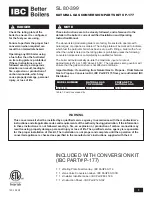
25
VENTING
CONNECTIONS
General
Definition of Appliance Categories
Boilers are divided into four categories based on the
pressure produced in the exhaust and the likelihood of
condensate production in the vent.
Category I:
A boiler which operates with a non-pos-
itive vent static pressure and with a vent gas
temperature that avoids excessive condensate pro-
duction in the vent.
Category II:
A boiler which operates with a non-pos-
itive vent static pressure and with a vent gas
temperature that may cause excessive condensate
production in the vent.
Category III:
A boiler which operates with a positive
vent pressure and with a vent gas temperature that
avoids excessive condensate production in the vent.
Category IV:
A boiler which operates with a positive
vent pressure and with a vent gas temperature that
may cause excessive condensate production in the
vent.
See Table J for vent category requirements for the
Advanced Design Boiler.
CAUTION:
Proper installation of flue exhaust
venting is critical for the safe and efficient operation
of the boiler. For vent systems not shown in this
section please contact your local authorized
representative.
CAUTION:
Stable vent pressure is critical to the
safe and proper operation of the heater. A
combination of barometric dampers, balancing
dampers, extractors, or draft inducers may be
required to stabilize the vent pressure.
NOTE:
For additional information on appliance
categorization, see appropriate ANSI Z21 Standard
and the latest edition Standard of National Fuel Gas
Code or in Canada, the latest edition of CSA
Standard B149 Installation Code for Gas Burning
Appliances and Equipment, or applicable provisions
of local building codes.
A
D
B
V
E
N
T
I
N
G
A
R
R
A
N
G
E
M
E
N
T
S
Tight
Tight
Table J: ADB Category Determination for Venting Purpose and Venting Arrangement
NOTE: PVC or CPVC vent may be used in conjunction with CHX, special piping arrangement has to be made. Contact manufacturer for details.
Summary of Contents for 751
Page 2: ...2...
Page 6: ...6 Component Locations Fig 1 Component Locations...
Page 15: ...15 Fig 6 Dual Boiler Piping Fig 7 Dual Boiler Piping with CHX...
Page 20: ...20 Fig 13 Single Boiler Pool Application Fig 14 Single Boiler Pool Application with CHX...
















































